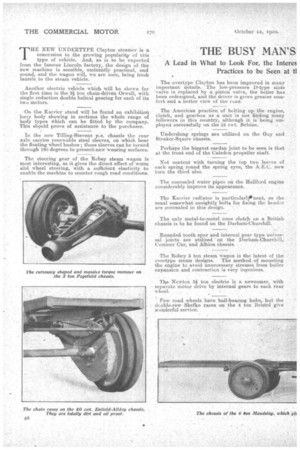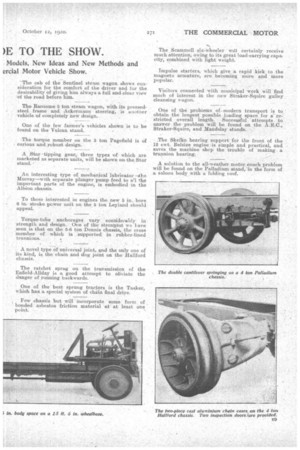THE BUSY MAN'S )E TO THE SHOW.
Page 28

Page 29

Page 30

Page 31

If you've noticed an error in this article please click here to report it so we can fix it.
THE NEW IINDERTYPE Clayton steamer is a concession to the growing popularly of this type of vehicle. And, as is to be expected from the famouS Lincoln factory, the design of the new machine is sensible, eminently practical, and sound,. and the wagon will, weare sure, bring fresh laurels to the steam vehicle.
Another electric vehicle which will be shown for the first time is the 24 ton chain-driven Orwell, with single redaction double helical gearing for each of its two motors, On the Karrier stand will be found an exhibition lorry body showing in sections the whole range of body types which can be fitted by the company. This should prove of assistance to the purchaser.
In the new Tilling-Stevens p.e. chassis the rear axle carries renewable steel sleeves, on which bear the floating wheel bushes; these sleeves can be turned through 180 degrees to presentinew 'wearing surfaces.
The steering gear of the Robey steam wagon is most interesting, as it gives the direct effect of worm afid wheel steering, with a sufficient elasticity to enable the machine to counter rough read conditions. The overtype Clayton has been improved in many important details. The low-pressure 1)-type slide 'valve is replaced by a piston valve, the boiler has. been redesigned, and the driver is given greater comfort and a better view of the road: The American practice of bolting up the engine, clutch, and gearbox asa unit is not finding many followers in this country,. although it is 'being employed .suCcessfully on the .12 cwt. Belsize.
Underslung springs are utilized on the Guy and Straker-Squire chassis.
Perhaps the biggest cardan joint to be seen is that at the front end of the Caledon propeller shaft.
Not content with turning the top two leaves of each spring round the spring eyes, the A.E.C. now turn the third also.
The concealed water pipes on the Hallford engine considerably improve its appearance.
The Karrier radiator is partienIarlPneat, as the usual somewhat unsightly bolts, for fixing the header are concealed in this design.
The only metal-to-metal cone .clutch on a Britishchassis is to be found on the Durham-Churchill.
Rounded tooth spur and internal gear type universal joints are utilized on the Durham-Churchill, Comrner Car, and Albion chassis.
The Robey .5 ton steam wagon is the latest of the overtype steam designs. The method of mounting the engine to avoid unnecessary stresses from boiler expansion and contraction is very ingenious, The Newton 24 ton electric is a newcomer, with separate motor drive by internal gears to each rear.
wheel. • • Few road wheels have ball-bearing hubs/ but the double-row Skefko races on the 4 ton Bristol give wonderful service-. The cab of the Sentinelsteam wagon shows consideration for the comfort of -the driver and for the desirability of giving him always a full and clear view of the road before him.
The Ransome 5 ton steam wagon, Iv].'th its pressedsteel frame and Ackermann steering, is another vehicle of completely new design.
One of the few farmer's vehicles shown is to be found on the Vulcan stand.
The torque member on the 3 ton Pagefield is of curious and robust design.
A Star -tipping gear,: three types of which are marketed as separate units, will be shown on the Star stand.
An interesting type of mechanical lubricator -ho Murray—with separate plunger pump feed to a'l the important parts of the engine, is embodied in the Albion chassis.
To those interested in engines the new 5 in. bore 6 in. stroke power unit on the 5 ton Leyland should appeal. • Torque-tube anchorages vary considerably in strength and design. One of the strongest we have seen is that on the 5-6 ton Dennis chassis, the cross member of which is supported in rubber-lined trunnions.
A novel type of universal joint, qncl the only one of its kind, is the chain and dog joint on the Hanford chassis.
The ratchet sprag on the transmission of the Enfield-Allday is a. good attempt to obviate the danger of running backwards.
One of the best sprung tractors is the Ta.s.ker, which has a special system of chain final driye.
, Few chasais but will in-corporate some form of bonded asbestos friction material at at least one point. The Scammell six-wheeler will certainly receive much attention, owing to its great load-carrying capacity, combined with light weight.
Impulse starters, which give a rapid kick to the magneto armature, are be-coming more and more popular.
Visitors connected with municipal work will find much of interest in. the new Straker-Squire gulley cleansing wagon.
One of the problems of modern transport is to obtain the longest possible loading space for a" restricted overall length. Succes.sful attempts to answer the problem will be found on the A.E.C., Straker-Squire, and Maudslay stands.
.The Skefko bearing support • for the front of the 12 cwt. Belsize engine is simple and practical, and saves the machine shop the trouble of 'making a trunnion bearing.
A solution to the all-weather motor, coach problem will be found on the Palladium stand, in the form of a saloon body with a folding ioof. If the double cantilever springing on the Palladium chassis is not the last word, it is not far removed from it.
The Scammell " Billingsgate" trailer sounds a fishy proposition.
Many big-ends are still lubricated from troughs.
The Guy method of lubricating the valve stems (which are enclosed by dust-proof covers) by oil vapour from the crankcase is to be commended.
Detachable cylinder heads appear to be on the increase, and, when well designed, they certainly render decarbonization a simple task.
Much interest will certainly centre round the BurtMcCollum single sleeve-valved engine on the Caledon chassis. . .
The Unifiow ateel ball valve engine on the Atkinson steamer will appeal to viSitors interested in both petrol and steam exhibits.
graphite and phosphor-bronze oilless bushings, although not used so much as might be expected, are gaining ground, particularly on the Straker-Squire and Caledon chassis.
The spring brake pressure governor on the Guy will probably do a lot to reduce tyre eosts.
Brake operating rods often twist through frame torsion and unequal lifting of the rear wheels and, consequently, cause trouble by unscrewing thea!djusting nuts usually provided. A satisfactory sOlutiontof the difficulty is obtained by the employment of flat strip steel, which can itself twist.
The Maudslay chassis, with the driver's position next the engine, gives a 21 ft. 6 in. platform on a 15 ft. 6 in. wheelbase.
It cannot be proved at the Show, but tile 29 seater single deck Daimler bus is claimed to be entirely free from rattle. But the luxurious character of the seating can be tested.
El° The body of the Daimler 29 seater single deck bus weighs 22 cwt. The weight of the Bristol bus body, seating 29 passengers, is 221 cwt.
The only lorry at the Show on which the driver is positioned over the engine will be on the Pagefield stand. Incidentally, this vehicle has an 8 ft. wheelbase.
The practice of supporting the change-speed operating mechanism by the gearbox so that it is not affected by frame torsion is becoming more anti more standard.
There appears, to be quite a spirited contest between Michelin steel disc wheels fitted with Michelin twin pneumatics and single giant pneumatics for the rear wheels of many passenger-carrying vehicles.
Two universal joints of unusual type are to be found on the clutch shaft of the 2 ton Dennis,Portland ; these consist of six large steel 'balls working , in sockets in the shaft,. and in the muff forming the other portion of the coupling.
Water pumps sometimes give considerable trouble owing to leakage, wear on bushes, etc., and in several engines manufacturers, desiring something more than thermo-syphonie circulation, assist this by providing a small water. impeller on an extension of the fan shaft. Examples will be found on the Straker-Squire and W. and G. chassis, amongst others.
David Brown F.J. type worm gearing, with its remarkable efficiency, is-being employed on a great ma.nv■.c-hassis, although not all the makers mention the fact.
At least one manufacturer has dispensed withcrankcase inspection doors, in the belief that, in the modern engine, these are seldom, if ever, used. With no inspection doors, the crankcase can be made lighter and yet more rigid, and production costa are reduced.
A double laminated spring drive is employed between the engine and the dynamo on the TillingStevens petrol-electric chassis. The use of rivets in frames is decreasing rapidly, their place being taken by bolts.
Final drive by roller chains still finds many adherents, and when the chains are well protected from dust and run in oil, they provide one of the most satisfactory forms of drive known, considerably reducing the unsprung weight, and, if the chaincases are well designed, being quite accessible.
The unusual but simple gear selector mechanism on the Bristol chassis deserves consideration.
There is an increasing tendency to make engines self-governing by reducing valve areas so that wiredrawing occurs at above the desired limit of speed.
With many chassis approaching perfection, more attention is being paid to the matter of appearance in the way of handsome radiators with rounded fronts and elaborately designed cast or enamelled names. Some makers swear by fabric universal joints, others swear at them. The point of view depends on what they are expected to stand. It is unfair to position them to take braking stresses as well as torque, and often with considerable angular movement.
'In several engines the cylinders are cast en bloc with the top half of the crankcase. Typical British examples of this are the Straker-Squire and the 2 ton Thornycrof t.
'Centrally positioned change-speed and brake levers following American practice, are gradually coming into vogue, and will be seen on several chassis, including the two ton Dennis, the Bristol, the Austin, and the two ton Dennis-Portland.
Ferodo and steel clutches, with single or multiple discs, are rapidly increasing in popularity on new chassis, and bid fair to oust the cone type.




























































